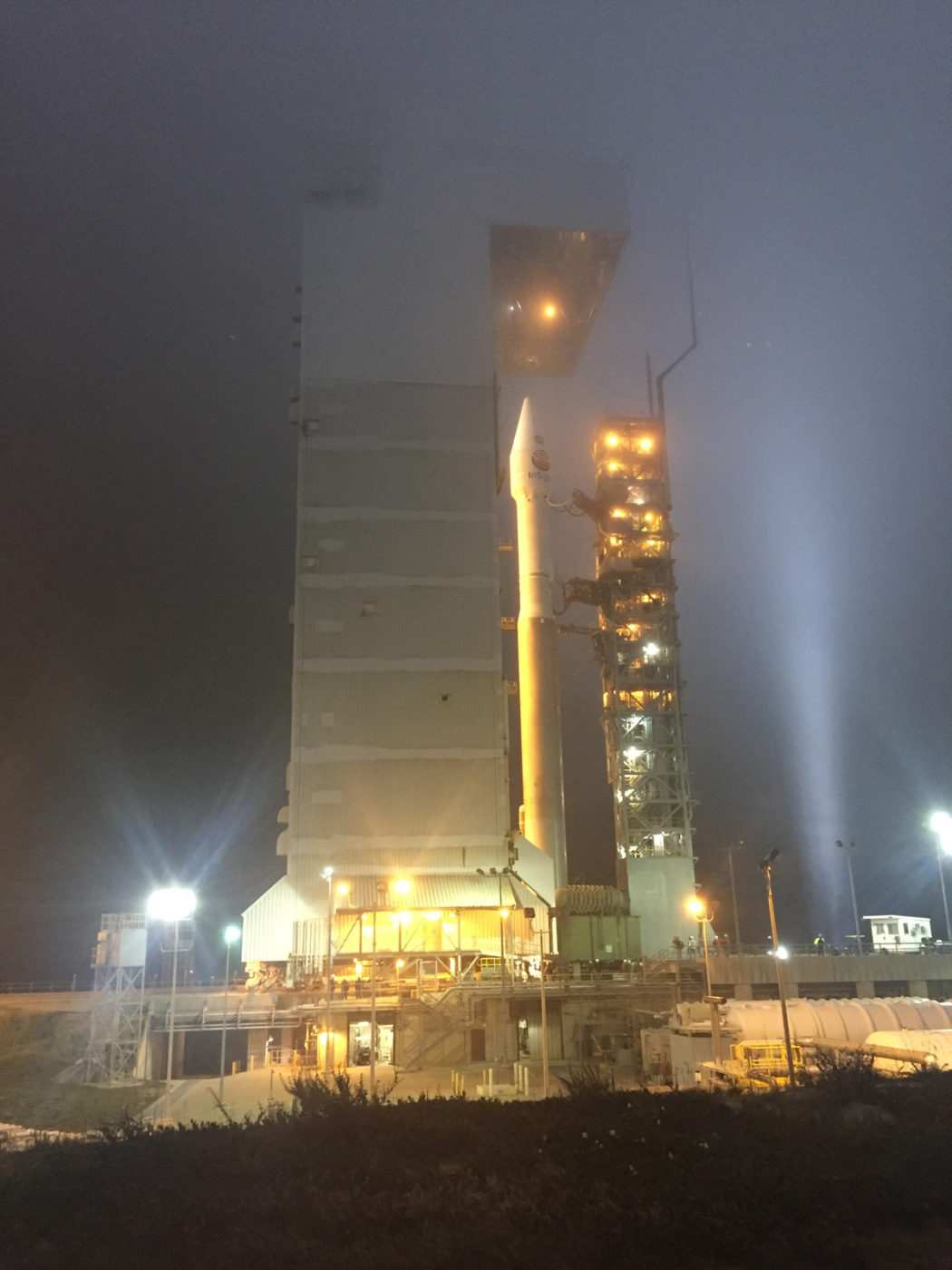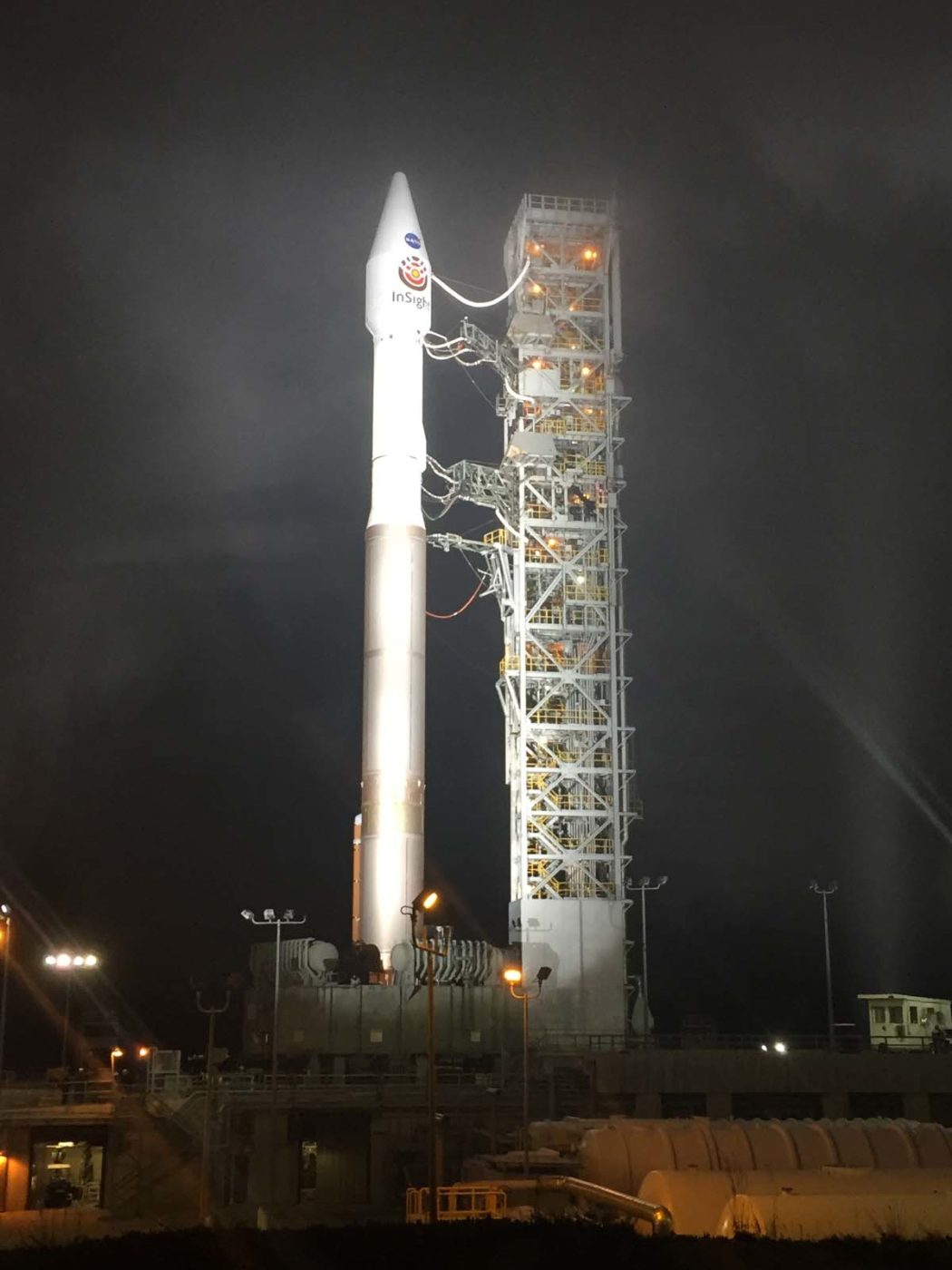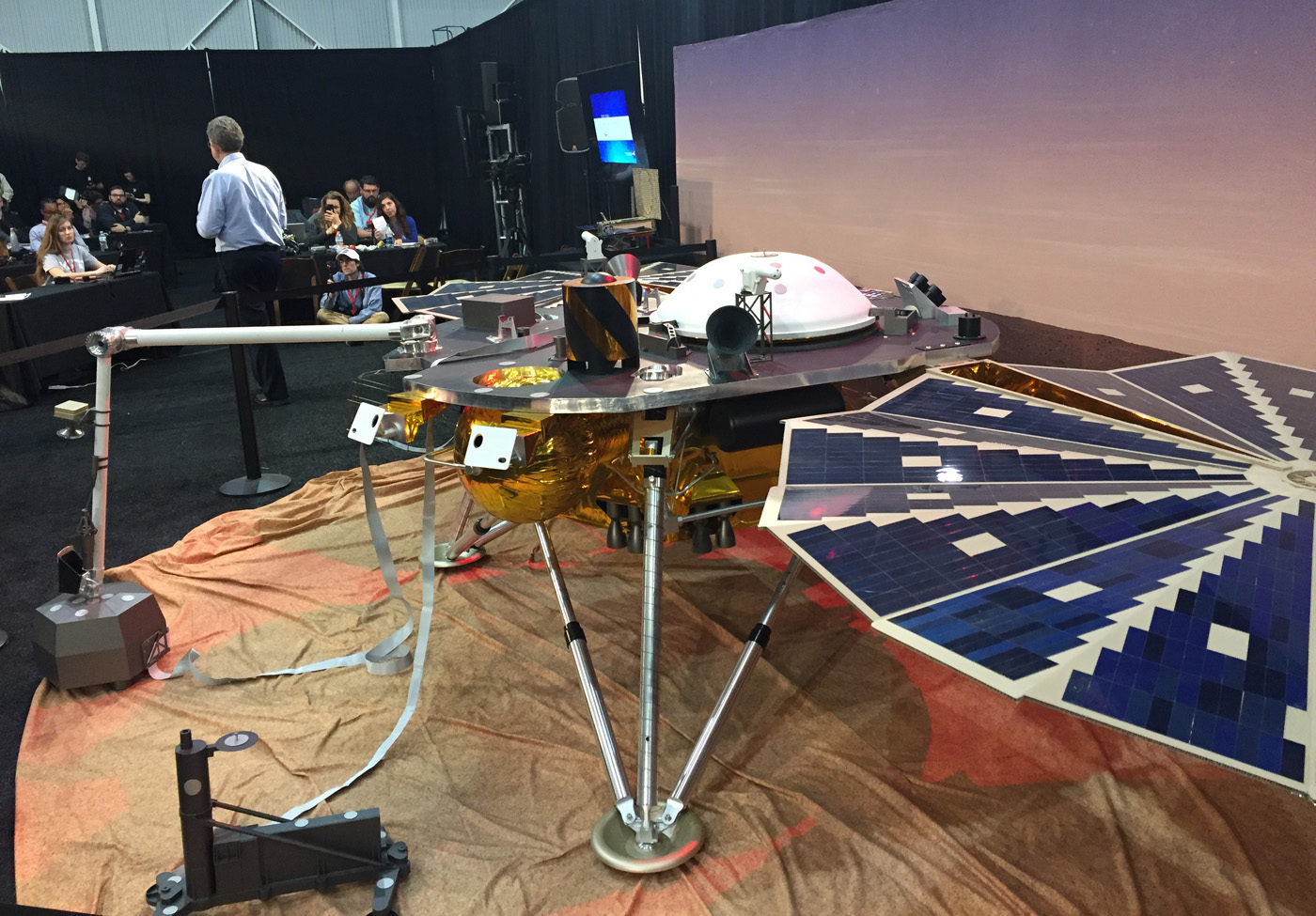May 13, 2018 9:00 pm
InSight Launch to Mars!
Today’s guest post is by Natalie Starkey. Natalie is a space scientist currently working as an author and science communicator, as well as being a host for StarTalk All-Stars. Beginning her scientific career as a geologist, she moved into space science after her PhD and started analysing comet and asteroid samples…and a few rocks from the Moon and Mars! Her first popular science book “Catching Stardust: comets, asteroids and the birth of the Solar System” is out in the US on June 5th and she is currently working on her second book called “Fire & Ice”, about space volcanoes. You can follow Natalie @StarkeyStardust on Twitter and Instagram, or visit her website here.
At 4:05am on May 5th 2018 the NASA InSight (Interior Exploration using Seismic Investigations, Geodesy and Heat Transport) spacecraft launched from California to begin its six-month journey to study the deep interior of Mars. I was lucky enough to get an invite to the launch and prelaunch media briefing. I also got the chance to chat with Troy Hudson, a geologist and engineer who became involved with InSight in 2009. Troy is the JPL Instrument Manager and Systems Engineer for one of InSight’s main instruments, which we’ll learn more about in a bit.
Why are we going back to Mars?
You might be wondering why NASA are going to Mars again. Surely the red planet has been visited enough with all those landers, orbiters and rovers? Well, here’s the thing. There is still much to learn about the red planet and, in particular, what’s going on inside it. While previous missions have studied some of Mars’ surface in quite a bit of detail, we still don’t know enough about its inner workings.
The cool thing about Mars is that it might be frozen in an early-state, a bit like Earth looked a few billion years ago. The problem is, we can’t see that part of Earth history because it has been erased by plate tectonics and other geological activity. By studying Mars, we get a chance to see what our own planet was like when it was young. Not only that, but by knowing more about the interior of Mars, we can test models of Solar System formation and better predict the structures within, and conditions on, other planets.
Chatting with Troy, he explained: “By going to Mars and seeing what it’s like inside another planet more similar to the Earth than the Moon, we hope to get a better picture of what processes and tendencies govern the formation of rocky planets in general”.
This idea comes from the fact that we know the Earth quite well, since we live on it. Similarly, we know the Moon quite well thanks to the extensive Apollo program. However, we know the other planets that surround us less well, either because they are hard to get to, or because it is tough for spacecraft to operate on their surfaces. InSight lets us discover a new planet in depth, feeding back information about its formation and in turn the formation of other planets within, and even outside of, our Solar System.
Did you know that Mars experiences earthquakes, or rather, Marsquakes? These are just one of the things that the InSight lander will investigate. The quakes will let the scientists figure out the internal structure and composition of the red planet. InSight will also measure Mars’ ‘wobble’ to see how its North Pole moves over time. But InSight will also hammer into Mars, taking its temperature and finding out how much heat is still being released from the deep interior. So, let’s join InSight and have a deeper look inside Mars.
InSight mission
Thanks to the incredibly powerful Atlas V 401 rocket, InSight became the first interplanetary spacecraft to launch from the west coast of the USA. Since I live in California, I had been excited about getting the chance to see this launch for a long time. Unfortunately, thanks to the thick marine layer (or ‘sea fog’ to the uninitiated), I was only able to hear and feel the departure of InSight. While this was slightly disappointing, I’m just glad the fog didn’t completely prevent the spacecraft from launching, particularly as I’d been up all night waiting for it to bid us farewell.

InSight’s tower rollback has begun. Photo Credit: Natalie Starkey.
A few hours prior to launch I had the chance to view tower rollback. This is where the structure surrounding the rocket on the launch pad is driven away very slowly (around 5mph) until the rocket is standing free. It was a phenomenal site – even in the dark – as the Atlas V, with InSight sitting atop, gradually appeared. The fog actually made this whole experience even more atmospheric. Having never seen a rocket on the launchpad before I was shocked how small and skinny it looked.

InSight alone pre-launch. Photo Credit: Natalie Starkey.
Now that InSight has safely launched, it has a relatively quick transit to Mars, with its arrival at the red planet set for November 26th 2018. But, while chatting with Troy he explained how long this mission has been in the planning stages: “Our PI, Bruce Banerdt, has been trying to get a seismometer to Mars for more than 35 years, and aspects of this mission have been proposed to NASA previously. But you could count the official beginning of what is now about to head to Mars as 2012, when InSight was selected as the recipient of that round of Discovery program mission funding.”
You might not realise that InSight is not alone on its journey to Mars; hitching along for the ride are two CubeSats. These are miniaturised cube-shaped satellites, weighing around 30lbs each, used for space research. They are called Mars Cube One (MarCo) but have affectionately been named Wall-E and EVE after the Disney robots. They will be used to test deep space communication technologies for the first time. WALL-E and EVE will fly on their own course to Mars, just behind InSight. If they make it to Mars, they will relay information about InSight’s entry and landing too. But fear not, InSight’s success does not depend on these little CubeSats, it will forge ahead with or without them as they are paving the way for the use of CubeSats in future missions.
Landing on Mars
Insight’s landing on Mars will initially use a heat shield before it deploys a parachute. It will then experience a brief moment of freefall ahead of firing retro rockets to bring it gently to the surface. Once it reaches Mars the lander will wait around 16 minutes for the dust to settle from touchdown before it unfurls its large solar panels. It will then use a robotic arm to settle on the planet, finding suitable positions to place its instruments, with the whole process taking around two months. All the while it will communicate with the mission team back on Earth so they can check the ground around the lander is safe.

InSight replica showing deployed experiments and solar panels. Credit: Natalie Starkey.
InSight’s landing site will be Elysium Planitia; a flat, featureless, smooth plain chosen for its safety considerations. Since InSight is studying Mars’ interior, it doesn’t require interesting surface features like loose rocks that might prevent a successful landing. Troy said: “When we get those first pictures back they’re probably going to be the most boring pictures you’ve ever seen from the surface of Mars because it’s smooth and flat and boring, and it’s exactly what we want.”
Elysium Planitia is quite close to Gale Crater which is currently being explored by the Curiosity rover. Troy gave me some more insight (excuse the pun) into how this spot was chosen: “The entry, descent, and landing system requires that we land below a certain altitude to allow InSight’s parachute to deploy properly. Most of the constraints came from the lander and the mission duration. InSight is solar powered and must operate for a Mars year, so it needs to be near the equator to ensure it gets enough sun during any season. And for the same reason, we need to land in an area that isn’t too rocky, isn’t too dusty, and isn’t too windy. When you combine all those constraints, there actually isn’t a lot of Mars available to choose from, and Elysium Planitia offered the best, safest option.”
Using quakes and wobble to probe inside a planet
Despite what the Hollywood movies might have you believe, we can’t drill to the centre of the Earth. However, if we want to discover what’s going on down there then we can find out indirectly, by measuring and studying earthquakes. By looking at the way in which energy waves from earthquakes – which you can think of as Earth vibrations – travel through the planet, and at what speed, scientists can then calculate what the waves have passed through. Is it solid, liquid, or something in-between? Even though we don’t tend to give it much thought as we continue our busy lives on Earth’s surface, most people are aware that beneath our solid crust are a slightly squishy mantle, liquid outer core and solid inner core.
Scientists need seismometers – instruments that measure the motion of the ground – for these discoveries though. On Earth we are lucky enough to be able to easily place these little scientific laboratories pretty much wherever we want. This is not so easy on other planets. Sure enough, there are seismometers on the Moon because they were placed by the Apollo astronauts (and yes, the Moon experiences ‘moonquakes’ too).
InSight’s seismometer, called SEIS, won’t be the planet’s first but it is hoped to be much more effective than those that preceded it on the Viking landers. SEIS, being an instrument that is picking up energy waves from the interior of the planet, is sensitive. As such, it wants to avoid accidentally measuring all the interfering noise from the lander, such as its solar panels flapping in the wind, and anything else from the surrounding environment. As a result, SEIS will be covered by a wind and thermal shield after being lifted off the lander and placed next to it by the robotic arm.
SEIS won’t just be picking up Marsquakes, which might occur quite infrequently (although the number of quakes that occur on Mars is something that InSight will find out). Troy explained: “Seismic energy can come from a number of sources: contraction of the planet’s crust and mantle as it cools, and the long-term settling of the crust in response to stresses. An example of that latter case would be the emplacement of the huge Tharsis volcanic province. All of the mass that was extruded out onto the surface is weighing down the lithosphere and it’s probably still responding to that additional stress.”
Yet, there is another type of seismic activity on the planet. Meteorite impacts! Wayward space rocks from comets, asteroids and other planets don’t just collide with Earth, they fly all over the Solar System, colliding with any object they happen to find. When rocks from space hit the surface of a planet, the energy of impact releases waves just like when a quake occurs. These ‘meteorquakes’, as I’ll call them, can also be measured by SEIS and they will further help scientists to constrain the internal structure of Mars (they are just like bonus energy waves).
Hammering on Mars
How do you go about taking a planet’s temperature? Troy Hudson describes the HP3 (Heat Flow and Physical Properties Probe) instrument as ‘literally ground-breaking’. It is designed to hammer into the surface of Mars – burrowing 16 feet (that’s 5 meters) – deeper than anything has been on any planet to date. It will take sensors with it to measure the heat escaping from the deep interior of Mars. Troy explained: “We have a number of models that predict different heat flows depending on how Mars is today (for example, if its mantle is actively convecting or not). HP3 will be able to see which ones fit the ‘ground-truth’ data.”
Knowing what the planet’s heat flow looks like today allows scientists to work out the inventory of radioactive heat-producing elements that are trapped within Mars. These act as Mars’ heat engine, holding energy that can drive geological activity at the present day. With this information, scientists can wind back the clock to understand Mars’ history, how its internal state has changed since the days it had active volcanoes.
Measuring the wobble
Joining the science fun will be RISE (Rotation and Interior Structure Experiment), made up of a set of radio antennae designed to measured Mars’ ‘wobble’. This is really the movement of Mars’ North Pole as the planet orbits the Sun. RISE’s observations, along with SEIS, will help scientists figure out the size of Mars’ core, and even what it’s made of (solid, liquid or something in-between). By knowing more about Mars’ interior, scientists will better understand the processes that governed its formation and evolution.
Final thoughts
I asked Troy what he was most excited about, other than seeing his special HP3 instrument digging into Mars. “When I was growing up, the Voyager spacecraft were doing their Grand Tour of the Solar System. It was the first Golden Era of planetary science – all these worlds that formerly were just points of light were now real places. We have since visited up close nearly every major body in the solar system, including dwarf planets like Ceres and Pluto. We’ve seen their surfaces and have developed many new questions about what’s happening inside. It’s that endless possibility of exploration that fascinates me.” (For more from Troy Hudson, you can watch his lecture about InSight here.)
Watch this space
InSight’s primary mission is one Mars year, which is roughly two Earth years. However, history has shown us that the NASA engineers tend to build spacecraft that far exceed their expectations. Opportunity rover was set for 90 days on Mars and it has now surpassed 5000 days on the red planet, so there’s a good chance InSight could keep going for years. For updates about the mission follow NASA channels…and of course right here on StarTalk.
Get the most out of StarTalk!
Ad-Free Audio Downloads
Priority Cosmic Queries
Patreon Exclusive AMAs
Signed Books from Neil
Live Streams with Neil
Learn the Meaning of Life
...and much more

 Become a Patron
Become a Patron

